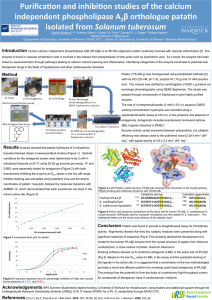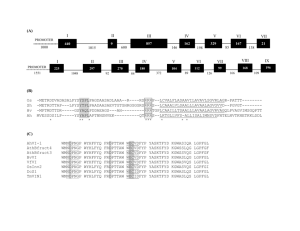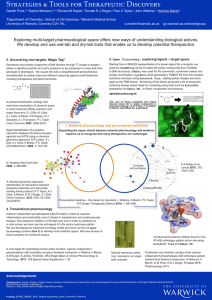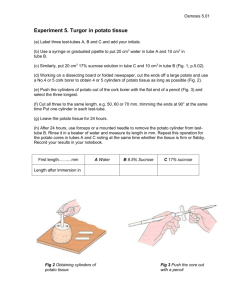Viterbo-Patatin poster-kgw
advertisement
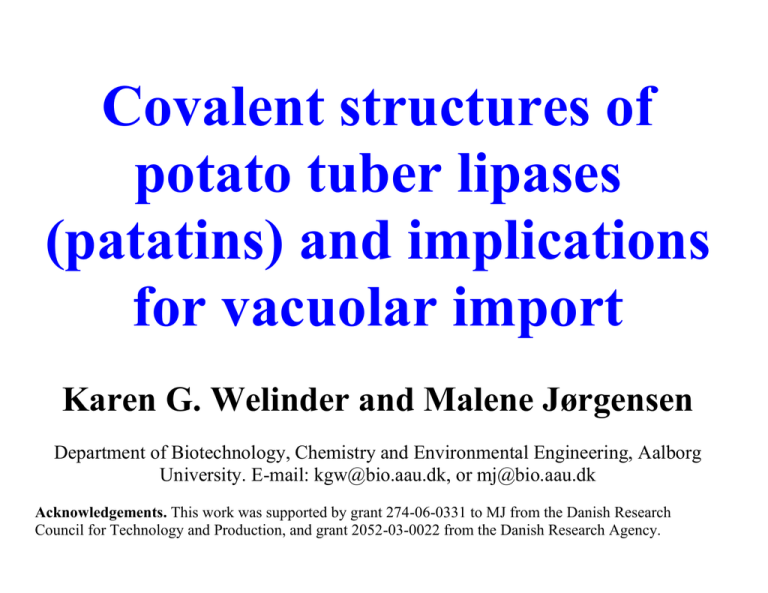
Covalent structures of potato tuber lipases (patatins) and implications for vacuolar import Karen G. Welinder and Malene Jørgensen Department of Biotechnology, Chemistry and Environmental Engineering, Aalborg University. E-mail: kgw@bio.aau.dk, or mj@bio.aau.dk Acknowledgements. This work was supported by grant 274-06-0331 to MJ from the Danish Research Council for Technology and Production, and grant 2052-03-0022 from the Danish Research Agency. Abstract Proteome data of potato (Solanum tuberosum) tuber juice and of purified potato tuber vacuoles indicated that mature patatins may perhaps lack a Cterminal (ct) propeptide. We have confirmed this by complete mass spectrometric sequencing of a number of patatin variants as well as their Nlinked complex-type glycans from the starch-rich cultivar Kuras. For this cultivar full length patatin cDNAs have also been sequenced, as the patatin locus is highly polymorphous. It is well-known that patatins are located in the vacuoles of potato tubers. Furthermore, the complex glycan structures show that the path is via the Golgi apparatus. However, the vacuolar targeting signal has never been identified for this storage and defence protein which amounts to 2540% of tuber protein. We propose that a six-residue ct-propeptide, -ANKASYCOO- composes this signal. The crystallographic structure of a recombinant patatin (Rydel et al., Biochemistry 42, 6696-6708), which included this propeptide thus, for the first time, shows the structure of a putative ligand of the vacuolar sorting receptor and processing enzyme responsible for patatin import. Welinder KG, Jørgensen M (2009) Covalent structures of potato tuber lipases (patatins) and implications for vacuolar import. J. Biol. Chem., Feb 2009; doi:10.1074/jbc.M809674200 Fig. 1 Alignment of translated patatin cDNA sequences using Kuras pat1-k1 as template Blue: sequenced peptides. Green: observed sites of complex N-linked glycans (see Fig. 2) Sites of N-Linked Glycans: Mass spectra of glycopeptides were extracted by searching for ions of 204.1 +/- 0.2 for GlcNAc (acetylated glucosamine), 366.1 +/- 0.2 for GlcNAc-Man1 and 528.2 +/- 0.2 for GlcNAc-Man2. Deglycosylation with Glycopeptidase A: Carboxymethylated patatin fractions were prepared and precipitated as described above. The pellet was dissolved in 15 µL 0.1 mM ammonium acetate pH 5 and incubated with 60 mU of glycopeptidase A from almonds for 18 h at 37 °C, dried by vacuum centrifugation, and digested with chymotrypsin as describe above. Fig. 2 Typical mass spectrometric collision-induced-dissociation fragmentation of a patatin glycopeptide (A). The same peptide obtained from enzymatically deglycosylated patatin (B). Ct-propeptide and vacuolar targeting Fig. 3 Model of pat-17 patatin at 2.2 Å resolution (1oxw, www.rcsb.org/pdb) The model of pat-17 high-lights the locations of glycans (green) and the interactions of the C-terminal residues of mature patatin. A recombinant form was expressed in E. coli with an N-terminal histidine tag and the ct-propeptide (Fig. 1). The structure shows the ct-propeptide sticking out from the remainder of the molecular surface. Therefore, the ctpropeptide including its free α-carboxylate, -ANKASYCOO– is easily accessible to a vacuolar sorting receptor. Indeed, the last ct-residues, ASY or ASF, are similar to the ends of many other ct-propeptides of vacuolar storage proteins. Vacuolar proteins are also bound to and cleaved by a vacuolar processing enzyme. We analyzed the interactions of the basic helical C-terminal residues 377-381 (blue side chains) of mature patatins within a 5 Å sphere. Invariant R377 is intimately bound to invariant D71 (red) in a binary mode via short 2.80 and 2.92 Å contacts between the terminal nitrogen atoms of the guanidinium group and the side chain carboxylate oxygens (salt bridge). One of the nitrogens has an additional 2.77 Å hydrogen bond to backbone carbonyl oxygen of methionine28 (residue 4 of mature patatin). We conclude that the C-terminal residues of mature patatins after R377 are loosely bound and, therefore, might easily unfold on binding to a processing enzyme. The processing enzyme is presently unknown in potato tuber vacuoles. As our proteomics data shows the cleavage being exclusively after R381 we propose that it might be an endopeptidase rather than an exopeptidase involved in removal of the six-residues patatin ct-propeptide.

